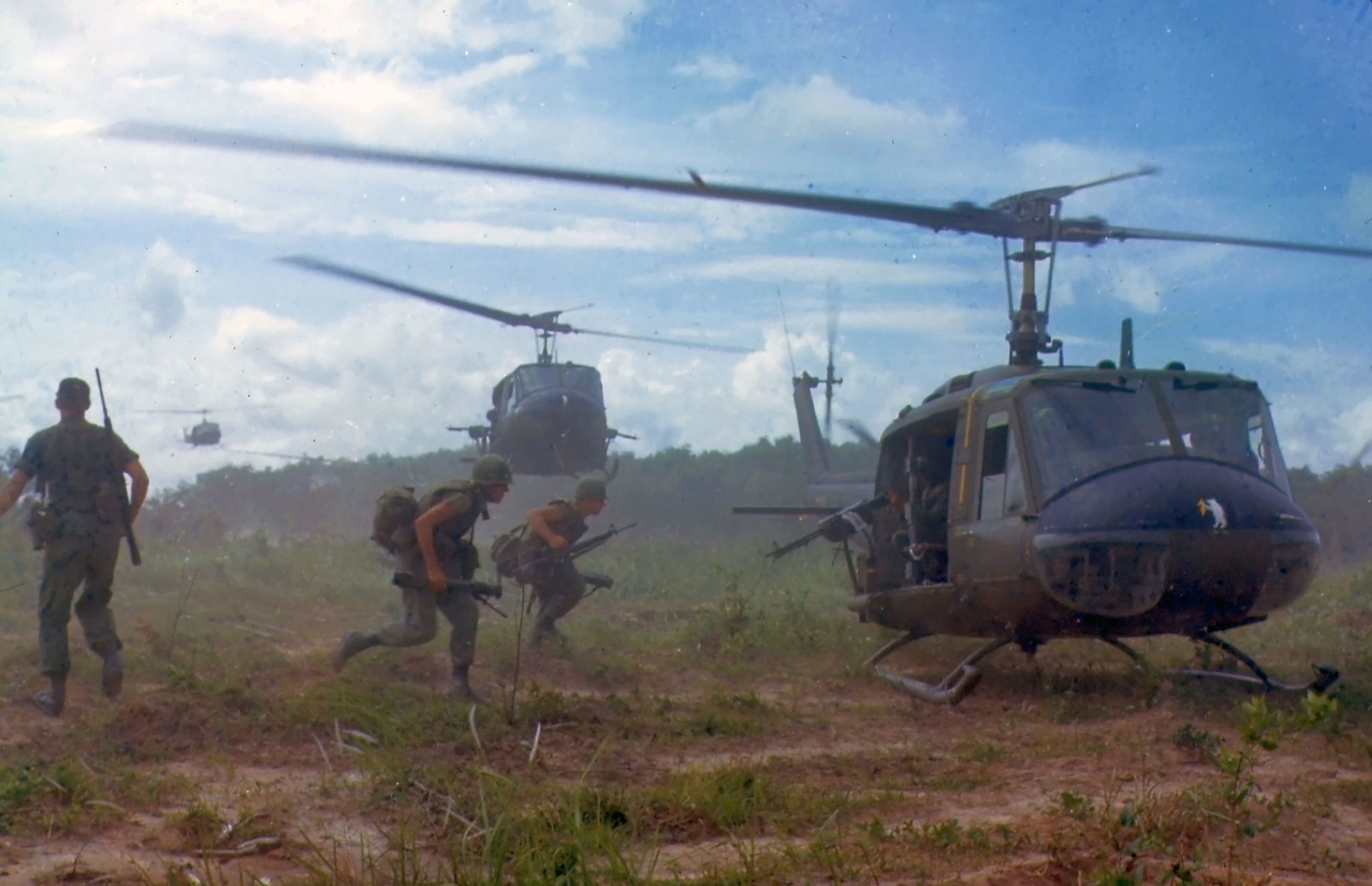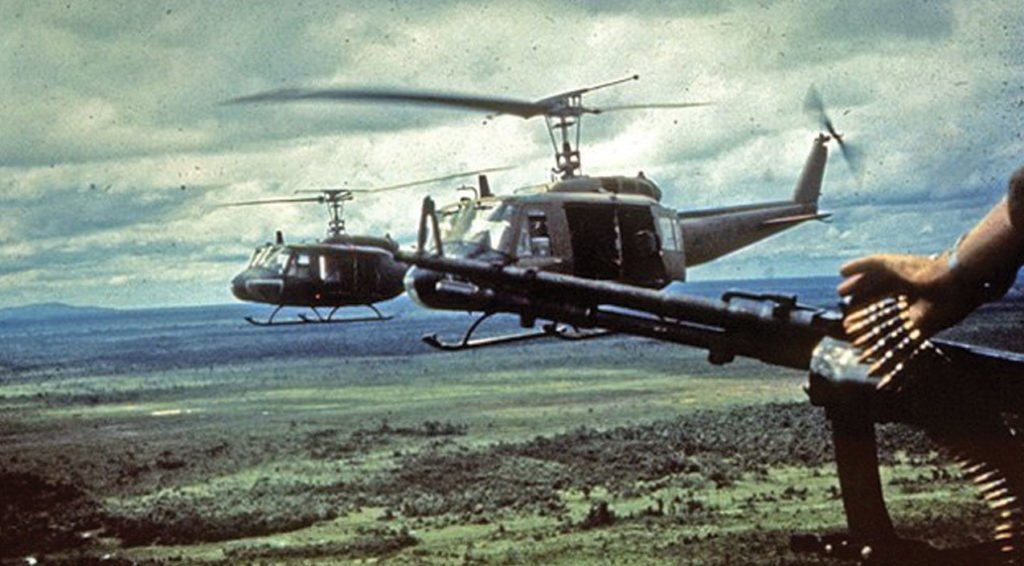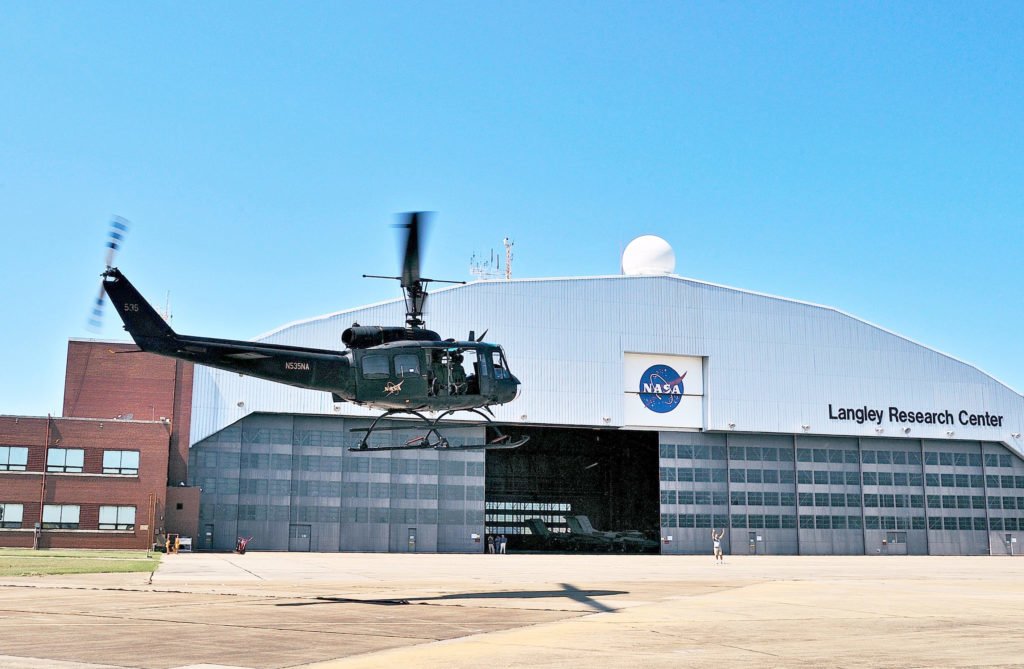
U.S. Army Bell UH-1D helicopters airlift members of the 2nd Battalion, 14th Infantry Regiment from the Filhol Rubber Plantation area to a new staging area, during Operation “Wahiawa,” a search and destroy mission conducted by the 25th Infantry Division, northeast of Cu Chi, South Vietnam, 1966. Photo by SFC James K. F. Dung, courtesy of the National Archives and Records Administration.
From 1955 to 1975, the Vietnam War wreaked havoc on North Vietnam and South Vietnam in a struggle to unify the nation. North Vietnam sought to force its southern counterpart into communism, while the south struggled to retain a Western view on government. The United States was one of many countries who became involved in the war, at first by sending military advisors to South Vietnam. This quickly increased to full military involvement from the United States, with President John F. Kennedy sending troops to the divided country.
When the United States joined in the war, they soon discovered that ground troops were next to useless due to Vietnam’s terrain. The vast jungles and mountains proved difficult to traverse, and it became clear that a new way of fighting was needed. The U.S. Air Force was tasked to design a new breed of helicopter, one that could be multifunctional. Bell Helicopter was awarded the contract for their Model 204 Helicopter.

The Model 204 was renamed the HU-1 Iroquois, soon thereafter referred to simply as the “Huey.” It was esteemed for its vertical takeoff and many uses. According to the “Battle Stations: Huey Helicopter- Air Armada” documentary, the introduction of the Huey also made possible the Pilot Program, which allowed soldiers without college degrees who joined with the sole intention to be a helicopter pilot to fly the new HU-1’s. The pilots and crew members who worked on these aircraft were a part of the 101st Air Cavalry, which comprised more than 500 helicopters and had the longest tour in history.
Three different versions of the Huey were used in the war. The Slicks, named after their smooth appearance with little to no armor or weaponry, were used as transports in place of jeeps and other military vehicles. These birds could carry eight fully armed soldiers on their way to battle the Vietcong and North Vietnamese Army, but they were next to defenseless and many were shot down before reaching their destination. The need for an armed Huey was presented — and so the gunship was born.
The Huey Gunship was a new concept with a potential that hadn’t been tapped into with the helicopters of World War II and the Korean War. They were heavily armed helicopters equipped with weapons to defend the Utility and Dust-Off Hueys. Their main purpose was to escort these two other units and rain firepower down on whoever challenged them. Some were equipped with miniguns that could fire up to 4,000 rounds per minute, while others could hold and fire up to 48 rockets. Even the mechanics that flew with them served as door gunners. The Gunship’s sole mission was to destroy the Vietcong, and before long, it succeeded in striking fear into their hearts whenever in earshot.
The Dust-Off units were medevac units, swooping into the thick of battle and carrying the wounded to a hospital for care. These units consisted of six Hueys, and each Huey carried a pilot, copilot, two medics, and had enough room for six stretchers. On average, it took a Dust-Off Huey 100 minutes to reach a hospital. Approximately 390,000 wounded were transported via the Dust Off; of that number, 90 percent of the wounded survived thanks to the Dust Off’s quick response time.

While the Huey was useful in the war, it was not without its problems. The rotors of the Huey were expected to last 1,000 flight hours before needing to be replaced. However, under the harsh Vietnam conditions, they needed replacements every 200 hours. In general, the Huey needed repairs frequently, and if a Huey was deemed illegal to fly due to damage, it was out of commission until repaired.
On top of their maintenance issues, the Huey’s were singled out and heavily targeted. To fly safely, the Huey needed to keep close to the treetops. This made for slow attacks, and they were still susceptible to ground fire from the enemy. They also only attacked their target up until they were 500 feet away, then turned around to avoid flying over the enemy. Pilots had a $25,000 reward on their heads, which made their job even more dangerous, but was a credit to their effectiveness in the skies above the battlefield. In the case where both a pilot and copilot were unable to fly due to an injury or death, a lever could be pulled by a crew member behind them and the seat would recline so they could be removed.
The Huey is an icon of the Vietnam War; some people even refer to it as the “Helicopter War.” Many veterans still remember the sound of its rotors beating against the thick Southeast Asian air, while others recall how it saved their lives. To the U.S. and South Vietnamese troops, it was a hero and a savior. To the Vietcong and NVA, it was a sign of imminent destruction. The military still uses this helicopter in certain capacities to this day, its multi-functionality a continued asset.

BRCC and Bad Moon Print Press team up for an exclusive, limited-edition T-shirt design!
BRCC partners with Team Room Design for an exclusive T-shirt release!
Thirty Seconds Out has partnered with BRCC for an exclusive shirt design invoking the God of Winter.
Lucas O'Hara of Grizzly Forge has teamed up with BRCC for a badass, exclusive Shirt Club T-shirt design featuring his most popular knife and tiomahawk.
Coffee or Die sits down with one of the graphic designers behind Black Rifle Coffee's signature look and vibe.
Biden will award the Medal of Honor to a Vietnam War Army helicopter pilot who risked his life to save a reconnaissance team from almost certain death.
Ever wonder how much Jack Mandaville would f*ck sh*t up if he went back in time? The American Revolution didn't even see him coming.
A nearly 200-year-old West Point time capsule that at first appeared to yield little more than dust contains hidden treasure, the US Military Academy said.












